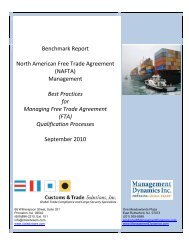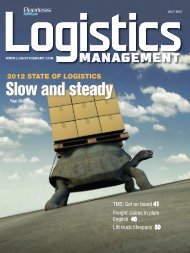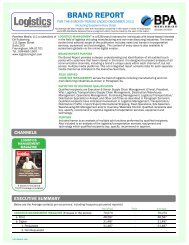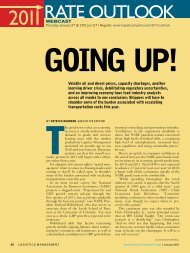Logistics Management - June 2010
Logistics Management - June 2010
Logistics Management - June 2010
You also want an ePaper? Increase the reach of your titles
YUMPU automatically turns print PDFs into web optimized ePapers that Google loves.
A special supplement to logistics management<br />
caused a three-year decline in real rates, perhaps as much as<br />
10 percent from 2006 through last year. “It would be nice to<br />
recover some of that this year,” he says.<br />
The bad news for TL carriers is that their costs are also<br />
rising. Besides $3-a-gallon diesel, there is expected to be<br />
some shortages of equipment and drivers. A new government<br />
initiative called Comprehensive Safety Analysis<br />
<strong>2010</strong> (CSA <strong>2010</strong>) is expected to weed out as many as 2<br />
percent to 7 percent of the nation’s 3 million long-haul<br />
truck drivers as their safety records get increased scrutiny<br />
and visibility.<br />
Besides fuel and wages, carriers are<br />
seeing financial affects from the rise in<br />
their health care costs, hours-of-service<br />
regulations, and new equipment costs.<br />
A new <strong>2010</strong> model Class 8 truck costs<br />
about $135,000 (before volume discounts<br />
for large fleets), about $35,000<br />
more than five years ago.<br />
“There is some sticker shock compared<br />
to what you paid the last time,”<br />
Quinn said. That increase translates to 5 cents to 8 cents a<br />
mile just to break even. “We’re going to have some unprecedented<br />
cost pressures…and it’s going to be a real sticker shock<br />
to some shippers.”<br />
Steve Williams, chairman and CEO of Maverick Transportation,<br />
the largest privately held trucking company in Arkansas,<br />
says he downsized his fleet by 20 percent (or 300 trucks)<br />
during the recession. But he adds that Maverick is currently<br />
rehiring drivers and other staff, but he is forced to raise wages<br />
to find experienced personnel.<br />
“We’re having a great deal of difficulty in attracting<br />
people back to start driving a truck. That’s not what we<br />
were expecting,” Williams says. “Unfortunately, it’s safe to<br />
say we’re going to have to raise driver wages. At the same<br />
time the cost of fuel has raised its ugly head again and we’re<br />
forced to spend money to ramp that back up. It’s not going<br />
to be easy rolling.”<br />
Truckload had its best pricing power from 2004 through<br />
2006. “But even in that time, the best years, the returns were<br />
pitiful,” says Williams. “If you start in a fairly poorly capitalized<br />
state in best of times, and you go to hell for three years,<br />
how optimistic should you really be”<br />
Williams is predicting “a sea change” in rates and costs during<br />
<strong>2010</strong> and 2011, driven by regulatory changes and demand levels.<br />
“It’s appropriate and necessary to build this new (pricing)<br />
model,” he adds. “The old random over the road TL model of<br />
last 30 years is really not sustainable in the future. Relationships<br />
with shippers are going to have to be more mature, and<br />
everything is more complex. A lot of us are really getting tired<br />
of just scraping by.”<br />
“We’re having a great deal of<br />
difficulty in attracting people back<br />
to start driving a truck. That’s not<br />
what we were expecting.”<br />
— Steve Williams, chairman and<br />
CEO of Maverick Transportation<br />
The little guy’s view<br />
James Bozeman is president and CEO of J.M. Bozeman<br />
Enterprises in Malvern, Ark., a dry van carrier with $9 million<br />
in revenue annually. He operates 57 company-owned trucks<br />
and is representative of literally thousands of small, non-union<br />
TL carriers who get their business in niche areas, often when<br />
the likes of giants J.B. Hunt and Schneider National eschew<br />
an account or shipper.<br />
According to Bozeman, judging from his trucks, the<br />
economic recovery is real. “It’s been weird,” says Bozeman.<br />
“Our deal didn’t fall off in November<br />
and December as usual. January and<br />
February were decent and March was<br />
like…wow. We saw capacity come<br />
back in February and March that<br />
we’re really not used to seeing. In the<br />
last three weeks of April we saw rate<br />
increases coming.”<br />
Bozeman adds that his company is<br />
now getting business “on lanes that we<br />
don’t normally get.” He says shippers<br />
are calling with an air of desperation in their voice. That’s<br />
opened the way for higher rates in some cases, he says, which<br />
customers are paying.<br />
Like his bigger competitors, Bozeman also reports that<br />
he’s sensing some optimism out there regarding higher rates.<br />
While he’s concerned about the effect of $80-a-barrel oil and<br />
10 percent unemployment rates, demand levels and pricing<br />
appear strong. “We’re getting some people willing to do whatever<br />
they need to do to lock in rates,” he adds.<br />
A few predictions<br />
While predicting the economic future is always murky, TL<br />
executives say they’re “guardedly optimistic” about rates, especially<br />
in 2011. Increasingly, they’re ranking their customers as<br />
far as their ability to take rate increases. Those in the bottom<br />
10 percent or so can expect to receive overtures about possibly<br />
increasing rates.<br />
“Many of our customers have been very cooperative during<br />
the recession and we’ll continue to work with them,” says U.S.<br />
Xpress’ Quinn. “Others were not. There’s got to be some ranking<br />
if there’s going to be a shortage of equipment.”<br />
For a change, Quinn says, carriers “have a hammer instead<br />
of being hammered.” That supply-demand equation is being<br />
driven by hopes of a robust economic recovery and lack of adequate<br />
capacity. “Barriers to entry and price of new equipment<br />
are so high that nobody is rushing out to buy new equipment<br />
until there is some return for that risk and investment,” he<br />
says. “It isn’t there today.”<br />
Larkin adds that TL pricing power is “clearly not” where<br />
it was during 2004 and 2006 when many TL carriers enjoyed<br />
<strong>Logistics</strong> <strong>Management</strong> • <strong>June</strong> <strong>2010</strong> 63S

















